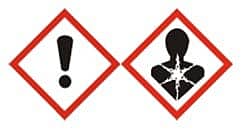Recent violations of OSHA’s Methylene Chloride Standard at a laboratory facility serve as a good reminder about the importance of handling this chemical safely. Methylene chloride (MC) is considered a highly hazardous chemical causing both acute and chronic health effects.
MC is a halogenated solvent also known as dichloromethane. It is commonly used in laboratories for drying resins in the final synthesis of solid phase peptides. MC is also used in pharmaceutical manufacturing. It is a colorless liquid with a chloroform-like or sweet ether-like odor.
Exposure Routes and Health Effects
The primary routes of exposure to MC are inhalation and absorption through the skin.
According to OSHA, employees exposed to MC are at an increased risk of developing cancer, as well as adverse effects on the heart, central nervous system and liver. Symptoms of exposure include skin and eye irritation, nausea, vomiting, lightheadedness, mental confusion, poor coordination, and breathing problems. Extremely high concentrations can result in pulmonary edema, unconsciousness, and death.
OSHA considers MC to be a potential human carcinogen. The International Agency for Research on Cancer (IARC) has classified MC as a Group 2B carcinogen, or possibly carcinogenic to humans. EPA considers MC likely to be carcinogenic in humans.
Odor is not considered a good warning property for MC. The odor threshold range is 1.2 ppm – 440 ppm (mean of 160 ppm). For most people, this is above the OSHA Permissible Exposure Limit (PEL) of 25 ppm and the Short Term Exposure Limit (STEL) of 125 ppm. In addition, MC is an anesthetic that will cause olfactory fatigue.
Exposure Monitoring
The Methylene Chloride Standard requires that employers conduct initial monitoring to determine each affected employee’s exposure. Personal breathing zone air samples can be obtained either for each employee’s exposure, or by taking representative samples of each employee’s exposure. Both PEL and STEL personal breathing zone air sampling must be conducted.
Monitoring is required unless there is objective data to demonstrate that MC cannot be released at or above the Action Limit (12.5 ppm) or above the STEL during the highest MC exposure likely to occur under reasonably foreseeable conditions of use (e.g., if all MC use was conducted in a properly functioning fume hood). If the employer chooses not to conduct sampling due to this exemption, documentation must be made in compliance with the Standard.
If monitoring results show exposure levels above the Action Limit or STEL, an exposure monitoring program must be established in accordance with Table 1 of the Standard. Depending on the exposure monitoring results, employers may be required to offer the employee the opportunity to participate in a medical surveillance program. Medical surveillance must also be offered in the event of an exposure to MC in an emergency situation.
Employees must be made aware of the monitoring results within 15 working days of receipt of the results. If results indicated exposure above the PEL or STEL, the employer is required to provide a written notification explaining the corrective action that will be taken to reduce exposure and a schedule of when the corrective actions will be completed.
Exposure Control
The Standard establishes requirements for employers to control exposure through the use of engineering controls (e.g., fume hoods, local exhaust drops), administrative controls (e.g., SOPs, training), and personal protective equipment including gloves, safety glasses or goggles (if splash potential exists), and lab coats.
In some cases, respiratory protection may be needed to reduce exposure levels. However, respiratory protection must be used as a last resort only, after all engineering control options have been investigated, and exposure levels remain above the PEL or STEL. It should also be noted that air purifying respirators (APR) are not a permissible method of protecting employees from inhalation exposure to MC because there are no cartridges that adequately filter MC. If respiratory protection is determined to be necessary, continuous flow supplied-air respirators or self-contained breathing apparatus (SCBA) must be used.
Regulated Areas
Any area where an employee’s exposure to MC can reasonably be expected to exceed the PEL or STEL must be considered a regulated area, in which only authorized personnel may have access. Regulated areas must be marked to alert employees of the hazard and minimize the number of authorized employees exposed to MC. Employers must also ensure that within a regulated area, employees do not engage in non-work activities which may increase dermal or oral MC exposure such as eating and drinking.
The employer is responsible for supplying respiratory protection selected in compliance with the Standard for employees entering regulated areas during times when exposures are expected to exceed the PEL or STEL.
For additional information on the requirements of the Methylene Chloride Standard, or for assistance implementing them at your facility, please contact us at [email protected].

